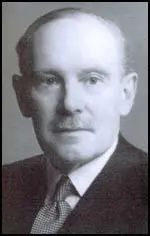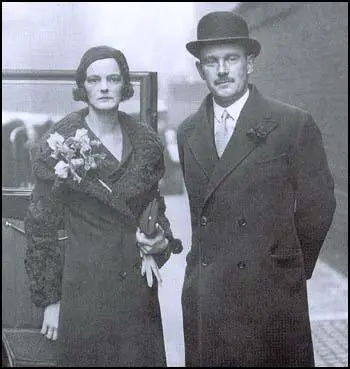Stewart Menzies

Stewart Menzies, the second son of John Graham Menzies (1861–1911) and his wife, Susannah West Wilson (1865–1943), was born in London on 30th January 1890. He entered Eton College in 1903, and there won prizes for languages that included the king's prize for German in 1907.
On leaving school, in 1909, he was commissioned in the Grenadier Guards. According to his biographer: "While in the army he acquired a love of horses and of hunting that remained with him for the rest of his life."
On the outbreak of the First World War he was sent to the Western Front with the British Expeditionary Force. He was awarded the Military Cross, after taking part in the major offensive in April 1915 at Ypres. After recovering from a gas attack he became a member of the staff of Sir Douglas Haig and worked in the counter-intelligence division at Montreuil. It was while working in this post he met Desmond Morton, Winston Churchill, Edward Louis Spears and Archibald Sinclair. As Gill Bennett, the author of Churchill's Man of Mystery (2009), has pointed out: "Menzies was also a close friend of Archibald Sinclair, who had introduced him to Churchill (Sinclair had become friendly with Churchill while both were learning to fly, and had served as Churchill 's second in command at Ploegsteert)."
Menzies married Lady Avice Ela Muriel Sackville, daughter of the eighth Earl Gilbert De La Warr and Muriel De Lar Warr on 29th November 1918. The marriage was not a success and he later married Pamela Thetis Beckett and she later gave birth to a daughter, Daphne.
In 1919 Menzies was appointed as head of the military division of the Secret Intelligence Service (SIS), also known as MI6. In the 1923 General Election, the Labour Party won 191 seats. Although the Conservatives had 258, Ramsay MacDonald agreed to head a minority government, and therefore became the first member of the party to become Prime Minister. As MacDonald had to rely on the support of the Liberal Party, he was unable to get any socialist legislation passed by the House of Commons. The only significant measure was the Wheatley Housing Act which began a building programme of 500,000 homes for rent to working-class families.
Stewart Menzies, like other members of establishment, was appalled by the idea of a Prime Minister who was a socialist. As Gill Bennett has pointed out: "It was not just the intelligence community, but more precisely the community of an elite - senior officials in government departments, men in "the City", men in politics, men who controlled the Press - which was narrow, interconnected (sometimes intermarried) and mutually supportive. Many of these men... had been to the same schools and universities, and belonged to the same clubs. Feeling themselves part of a special and closed community, they exchanged confidences secure in the knowledge, as they thought, that they were protected by that community from indiscretion."
In September 1924 the MI5 intercepted a letter signed by Grigory Zinoviev, chairman of the Comintern in the Soviet Union, and Arthur McManus, the British representative on the committee. In the letter British communists were urged to promote revolution through acts of sedition. Hugh Sinclair, provided "five very good reasons" why he believed the letter was genuine. However, one of these reasons, that the letter came "direct from an agent in Moscow for a long time in our service, and of proved reliability" was incorrect.
Vernon Kell, head of MI5 and Sir Basil Thomson head of Special Branch, were also convinced that the letter was genuine. Kell showed the letter to Ramsay MacDonald, the Labour Prime Minister. It was agreed that the letter should be kept secret but someone leaked news of the letter to the Times and the Daily Mail. The Zinoviev Letter was published in these newspapers four days before the 1924 General Election and contributed to the defeat of MacDonald and the Labour Party.
In a speech he made on 24th October, Ramsay MacDonald suggested he had been a victim of a political conspiracy: "I am also informed that the Conservative Headquarters had been spreading abroad for some days that... a mine was going to be sprung under our feet, and that the name of Zinoviev was to be associated with mine. Another Guy Fawkes - a new Gunpowder Plot... The letter might have originated anywhere. The staff of the Foreign Office up to the end of the week thought it was authentic... I have not seen the evidence yet. All I say is this, that it is a most suspicious circumstance that a certain newspaper and the headquarters of the Conservative Association seem to have had copies of it at the same time as the Foreign Office, and if that is true how can I avoid the suspicion - I will not say the conclusion - that the whole thing is a political plot?"
After the election it was claimed that two of MI5's agents, Sidney Reilly and Arthur Maundy Gregory, had forged the letter and that Major George Joseph Ball (1885-1961), a MI5 officer, leaked it to the press. In 1927 Ball went to work for the Conservative Central Office where he pioneered the idea of spin-doctoring. Later, Desmond Morton, who worked under Hugh Sinclair, at MI6, claimed that it was Stewart Menzies who sent the Zinoviev Letter to the Daily Mail. Menzies was promoted to the rank of colonel in 1932.

Hugh Sinclair, who had been suffering from cancer of the spleen, was taken into hospital in October 1939. Aware he was dying he sent a letter to William Ironside, the Chief of the Imperial General Staff: "I wish to place on record that, in my considered opinion, the most suitable individual, in every respect, to take my place, is Colonel Stewart Graham Menzies." This message was passed to the government and on the death of Sinclair on 4th November, 1939, Stewart Menzies was appointed as Director General of MI6.
His biographer, A. O. Blishen has pointed out: "Menzies was also responsible for the overall supervision of the Government Code and Cypher School (GCCS), whose greatest achievement in the war was the breaking, with considerable initial Polish and French help, of the German Enigma. This was an electro-mechanical enciphering and deciphering machine that was widely used by units of the German army, navy, and air force. German experts had rendered their machine so sophisticated that by the outbreak of the war they believed it safe even if captured. It was therefore used to communicate vital German war secrets. These began to be made available by GCCS by the end of 1940, and by the end of 1943 the school was decrypting as many as 40,000 naval and 50,000 army and air force messages a month."
Gill Bennett has argued that breaking the Enigma Code enabled Menzies to develop a very close relationship with Winston Churchill. "Stewart Menzies... welcomed the opportunity to ensure that Churchill got what he wanted. He was much less willing, however, to relinquish any control over his prime asset: the Enigma material supplied by the GC&CS codebreakers at Bletchley Park - Ultra, as it would later be called. Though still in its infancy in the summer of 1940, the source of intelligence, and in particular german Air Force (GAF) Enigma, played a valuable role both in giving warning of forthcoming air raids on Britain, and in providing details of GAF strengths and dispositions... It also laid the foundation for the closer relationship between the SIS Chief and the Prime Minister." Hugh Dalton, noted in his diary that Churchill considered Menzies "a wonderful fellow" and therefore... "we must not have quarrels" with him as he "has become so invulnerable".
Hugh Trevor-Roper, who worked with Menzies during the Second World War described him as "a bad judge of men" who "drew his personal advisers from a painfully limited social circle" and never "really understood the war in which he was engaged". William Cavendish-Bentinck, the chairman of the Joint Intelligence Sub-Committee, claimed that Menzies "was not a very strong man and not a very intelligent one" and that "he would not have held the job for more than a year if it had not been for" the work of Bletchley Park.
His second wife, Pamela Thetis Menzies, died in 1951. The following year he married Audrey Clara Lilian Chaplin. Menzies remained as Director General of MI6 until he was replaced by John Sinclair in July 1952.
Sir Stewart Menzies died in the King Edward VII Hospital for Officers, Beauchamp Place, London, on 29 May 1968.
Primary Sources
(1) Keith Jeffery, MI6: The History of the Secret Intelligence Service (2010)
It was not unusual in wartime Britain for men and women to work with little respite, but Menzies, like Cumming, seems to have been unusually committed to his job. His appointment diaries (which survive for all the war years except 1941) reveal no breaks longer than the occasional long weekend over the whole war. In August 1941 he made a special application for "Privacy Telephone Equipment" - a scrambler phone - to be installed at his home. "Without being able to talk freely to my office from my home," he explained, "I am virtually prevented from taking more than twenty-four hours leave, and now that the war has lasted nearly two years, I do feel occasionally the need for a little longer relaxation." Robert Cecil,
Menzies's personal assistant in 1943-5, asserted that he "rarely left his desk during the war". Partly this was to be available if a summons came from Churchill, which could happen at any time of the day or night. Cadogan noted an occasion in November 1942 when Churchill, "over-excited", sent for Menzies at 11.00 p.m., then said Menzies looked tired and had better go to bed. Menzies `admitted that he was, and would', but at 2.15 a.m. Churchill "rang him up to ask a quite unnecessary question - and then apologised!" The unremitting wartime workload was shared throughout the Service. Patrick Reilly noted that Menzies's private office was "staffed by two splendid women, Miss Pettigrew and Miss Jones, loyal discreet, working impossible hours". The former was "large and formidable", the latter "smaller, better looking, elegant and gentle ... Though they worked for several years in the same room they always called each other Miss Pettigrew and Miss Jones."
(2) Gill Bennett, Churchill's Man of Mystery (2009)
Stewart Menzies... welcomed the opportunity to ensure that Churchill got what he wanted. He was much less willing, however, to relinquish any control over his prime asset: the Enigma material supplied by the GC&CS codebreakers at Bletchley Park - Ultra, as it would later be called. Though still in its infancy in the summer of 1940, the source of intelligence, and in particular german Air Force (GAF) Enigma, played a valuable role both in giving warning of forthcoming air raids on Britain, and in providing details of GAF strengths and dispositions... It also laid the foundation for the closer relationship between the SIS Chief and the Prime Minister.

